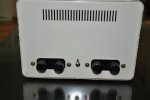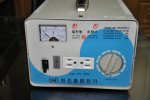2manynotez
Member
- Location
- Seoul, Korea
Forgive me first off as I am not an electrician. I have a question regarding a step down transformer and I figured there has to be a ton of experts on this forum that can answer it in their sleep. I live in Seoul and work for the USACE here in Korea.
Korea's residential power in older apartments, like mine, is 220v. Two hot legs, no neutral, no ground. (grounding is another issue for a later time)
I have a 5000w Step Down transformer with tap changer (2 down, 2 up). Without power connected, my ohm meter reads a completely open connection (no connection) between the 220 legs or the 110 legs to the Transformer Case.
When powered on, I get ~88 volts to the case from one 110 leg, and ~35 volts to the case from the other 110 leg. (This is the reading for both front outlets and the backside hard wire 110 terminals)
My question: is this normal, and why? The case is NOT grounded and is sitting on a vinyl floor.
The same exact readings happen with a 2000w Step Down transformer I have. I have used this transformer with no problem, except for no ground for surge protection, for 3 years like this and just today happened to bring out the Fluke.
I would really appreciate an experts opinion on this. I hope I have given you enough details to picture my conditions.
I have added photos of the front and back of the transformer. Note: even though you see a 3 prong outlet on the front, the ground on the two outlets are tied together inside and nothing else. They are just there to accept a 3 prong plug without adapter.
Thanks in advance for any help.
Korea's residential power in older apartments, like mine, is 220v. Two hot legs, no neutral, no ground. (grounding is another issue for a later time)
I have a 5000w Step Down transformer with tap changer (2 down, 2 up). Without power connected, my ohm meter reads a completely open connection (no connection) between the 220 legs or the 110 legs to the Transformer Case.
When powered on, I get ~88 volts to the case from one 110 leg, and ~35 volts to the case from the other 110 leg. (This is the reading for both front outlets and the backside hard wire 110 terminals)
My question: is this normal, and why? The case is NOT grounded and is sitting on a vinyl floor.
The same exact readings happen with a 2000w Step Down transformer I have. I have used this transformer with no problem, except for no ground for surge protection, for 3 years like this and just today happened to bring out the Fluke.
I would really appreciate an experts opinion on this. I hope I have given you enough details to picture my conditions.
I have added photos of the front and back of the transformer. Note: even though you see a 3 prong outlet on the front, the ground on the two outlets are tied together inside and nothing else. They are just there to accept a 3 prong plug without adapter.
Thanks in advance for any help.


